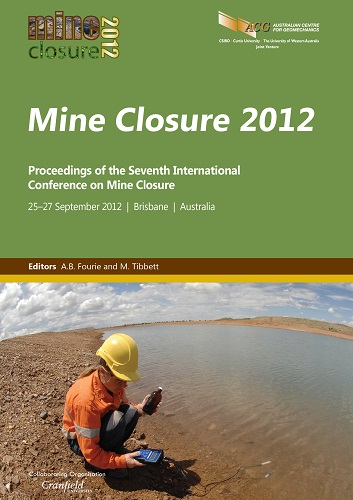Robust mine closure development and maintenance

|
Authors: Mitchell, IC |
DOI https://doi.org/10.36487/ACG_rep/1208_23_Mitchell
Cite As:
Mitchell, IC 2012, 'Robust mine closure development and maintenance', in AB Fourie & M Tibbett (eds), Mine Closure 2012: Proceedings of the Seventh International Conference on Mine Closure, Australian Centre for Geomechanics, Perth, pp. 241-250, https://doi.org/10.36487/ACG_rep/1208_23_Mitchell
Abstract:
Mine closure planning is becoming increasingly more rigorous both nationally and internationally. Greater expectations are being placed on industry from the community, industry itself and from within government to ensure mining and in particular rehabilitation and closure are completed in an ecologically sustainable manner. From the community perspective, these expectations have come from a growing awareness of environmental issues and the need for an increase in environmental protection. The mining industry understands and accepts the responsibility it has for mine rehabilitation and closure. The industry recognises that in failing to address rehabilitation and closure issues correctly, its reputation is affected. The industry also recognises that to gain access to future resources it needs to demonstrate that it can close mines effectively (DITR, 2006a). From the government perspective, a greater emphasis is being placed on mine closure planning to ensure processes are in place and mines are closed in a way so as to not cause unacceptable liability to the government (Western Australian (WA) Department of Mines and Petroleum (DMP), 2011). This paper will present an overview of the WA ‘Guidelines for Preparing Mine Closure Plans’, introduced in July 2011 and jointly prepared by the DMP and the Environmental Protection Authority (EPA). A component of these guidelines requires companies to undertake a review and re-submit their Mine Closure Plans (MCP) every three years. The guidelines require ongoing collection and analysis of significant amounts of rehabilitation and closure data, and require proponents to detail how this information and data will be managed. It will therefore be critical for mines to improve their data management capabilities. The paper will provide an insight into the development of systematic and robust MCPs, and the maintenance and refinement of closure plans through the operating phase and beyond. The paper will also discuss the use of electronic tools that assist and streamline the data management and review process to save time and resources for mining companies.
References:
Australian and New Zealand Minerals and Energy Council (ANZMEC) and Minerals Council of Australia (MCA) (2000), Strategic Framework for Mine Closure, National Library of Australia Catalogue Data.
Bentel, G.M. (2009) Key Closure Planning Considerations, in Proceedings Fourth International Conference on Mine Closure (Mine Closure 2009), A.B. Fourie and M. Tibbett (eds), 9‒11 September 2009, Perth, Australia, Australian Centre for Geomechanics, Perth, pp. 41–54.
Clark, A.L. and Cook Clark, J. (1999) An International Overview of Legal Frameworks for Mine Closure, viewed 6 May 2012, .
DMP (2011) Department of Mines and Petroleum. Guidelines for Preparing Mine Closure Plans, dated June 2011, Western Australian Government, p. 3, p. 20, p. 22, p. 27, p. 32, p. 70, p. 72.
DITR (2006a) Department of Industry Tourism and Resources. Mine Closure and Completion Handbook, Australian Commonwealth Government, p. 1, p. 15.
DITR (2006b) Department of Industry Tourism and Resources. Mine Rehabilitation Handbook, Australian Commonwealth Government, p. 65.
Friedel, A., Birch, S., Kentwell, J., Moiler, K. and Yáñez, B.M. (2012) Keeping it simple: selecting appropriate vegetation-based completion criteria for mine site rehabilitation, In Proceedings of Workshop on Environmental Management, May 2012, Kalgoorlie, Western Australia.
Jasper, D. and Braimbridge, M. (2008) Waste Characterisation for Optimal Landforms, In Proceedings of Workshop on Environmental Management, May 2008, Kalgoorlie, Western Australia.
South Australian Government (2007) City of Charles Sturt Community Engagement Model, viewed 12 May 2012, .
USEPA (2011) United States Environmental Protection Agency. Biological Indicators of Watershed Health – Data Management, viewed 7 July 2012,.
Western Australian Department of State Development (2009), Stakeholder Consultation Information sheet, viewed 10 April 2012, .
© Copyright 2025, Australian Centre for Geomechanics (ACG), The University of Western Australia. All rights reserved.
View copyright/legal information
Please direct any queries or error reports to repository-acg@uwa.edu.au
View copyright/legal information
Please direct any queries or error reports to repository-acg@uwa.edu.au